Nursing Assignment 4: Self-Determination in Aboriginal Healthcare
VerifiedAdded on 2022/09/05
|5
|1117
|8
Report
AI Summary
This nursing assignment examines the Aboriginal Medical Services (AMS) established in Australia in the 1970s, focusing on how their development and operation align with the primary health care principle of self-determination. The report highlights the historical context of AMS, the health disparities faced by Aboriginal and Torres Strait Islander peoples, and the importance of self-determination in achieving health equity. It describes the services provided by AMS, including clinical care, emergency services, and preventive care, and emphasizes the role of community control and participation in healthcare planning and delivery. The assignment discusses the impact of AMS in reducing barriers to healthcare access, promoting health literacy, and empowering the Aboriginal community. It also references relevant literature to support the analysis and concludes with the importance of continued federal funding and community involvement for improved health outcomes.
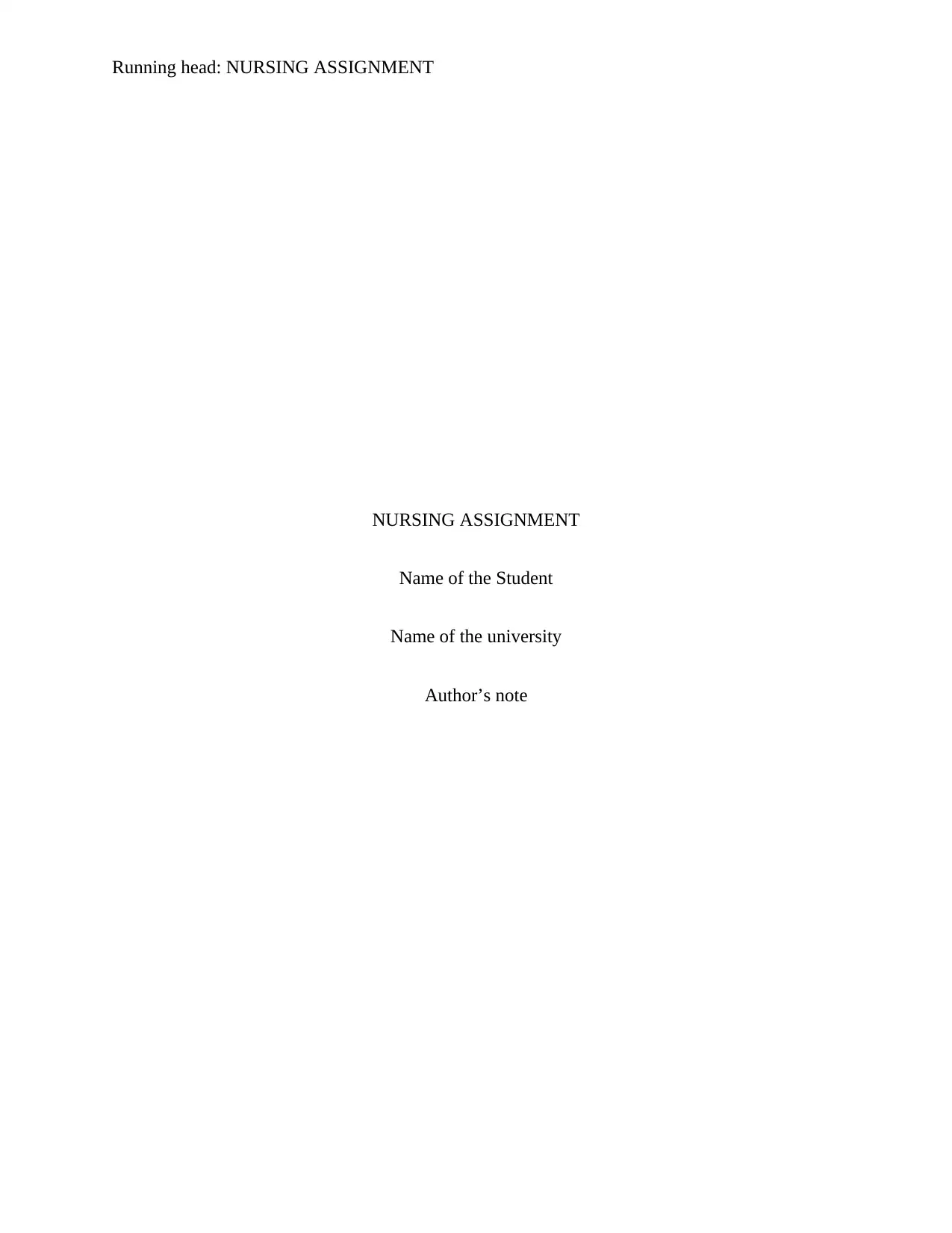
Running head: NURSING ASSIGNMENT
NURSING ASSIGNMENT
Name of the Student
Name of the university
Author’s note
NURSING ASSIGNMENT
Name of the Student
Name of the university
Author’s note
Paraphrase This Document
Need a fresh take? Get an instant paraphrase of this document with our AI Paraphraser
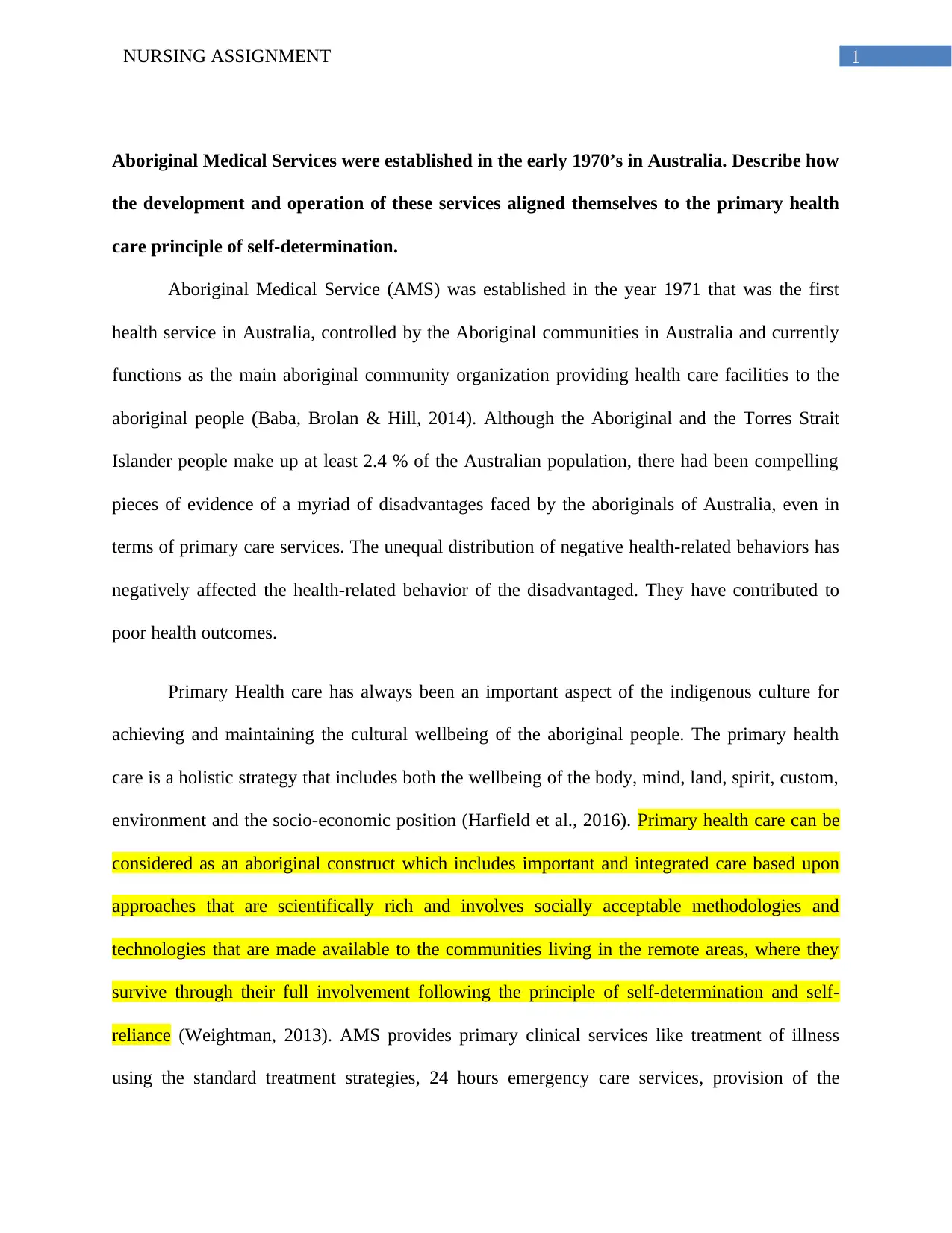
1NURSING ASSIGNMENT
Aboriginal Medical Services were established in the early 1970’s in Australia. Describe how
the development and operation of these services aligned themselves to the primary health
care principle of self-determination.
Aboriginal Medical Service (AMS) was established in the year 1971 that was the first
health service in Australia, controlled by the Aboriginal communities in Australia and currently
functions as the main aboriginal community organization providing health care facilities to the
aboriginal people (Baba, Brolan & Hill, 2014). Although the Aboriginal and the Torres Strait
Islander people make up at least 2.4 % of the Australian population, there had been compelling
pieces of evidence of a myriad of disadvantages faced by the aboriginals of Australia, even in
terms of primary care services. The unequal distribution of negative health-related behaviors has
negatively affected the health-related behavior of the disadvantaged. They have contributed to
poor health outcomes.
Primary Health care has always been an important aspect of the indigenous culture for
achieving and maintaining the cultural wellbeing of the aboriginal people. The primary health
care is a holistic strategy that includes both the wellbeing of the body, mind, land, spirit, custom,
environment and the socio-economic position (Harfield et al., 2016). Primary health care can be
considered as an aboriginal construct which includes important and integrated care based upon
approaches that are scientifically rich and involves socially acceptable methodologies and
technologies that are made available to the communities living in the remote areas, where they
survive through their full involvement following the principle of self-determination and self-
reliance (Weightman, 2013). AMS provides primary clinical services like treatment of illness
using the standard treatment strategies, 24 hours emergency care services, provision of the
Aboriginal Medical Services were established in the early 1970’s in Australia. Describe how
the development and operation of these services aligned themselves to the primary health
care principle of self-determination.
Aboriginal Medical Service (AMS) was established in the year 1971 that was the first
health service in Australia, controlled by the Aboriginal communities in Australia and currently
functions as the main aboriginal community organization providing health care facilities to the
aboriginal people (Baba, Brolan & Hill, 2014). Although the Aboriginal and the Torres Strait
Islander people make up at least 2.4 % of the Australian population, there had been compelling
pieces of evidence of a myriad of disadvantages faced by the aboriginals of Australia, even in
terms of primary care services. The unequal distribution of negative health-related behaviors has
negatively affected the health-related behavior of the disadvantaged. They have contributed to
poor health outcomes.
Primary Health care has always been an important aspect of the indigenous culture for
achieving and maintaining the cultural wellbeing of the aboriginal people. The primary health
care is a holistic strategy that includes both the wellbeing of the body, mind, land, spirit, custom,
environment and the socio-economic position (Harfield et al., 2016). Primary health care can be
considered as an aboriginal construct which includes important and integrated care based upon
approaches that are scientifically rich and involves socially acceptable methodologies and
technologies that are made available to the communities living in the remote areas, where they
survive through their full involvement following the principle of self-determination and self-
reliance (Weightman, 2013). AMS provides primary clinical services like treatment of illness
using the standard treatment strategies, 24 hours emergency care services, provision of the
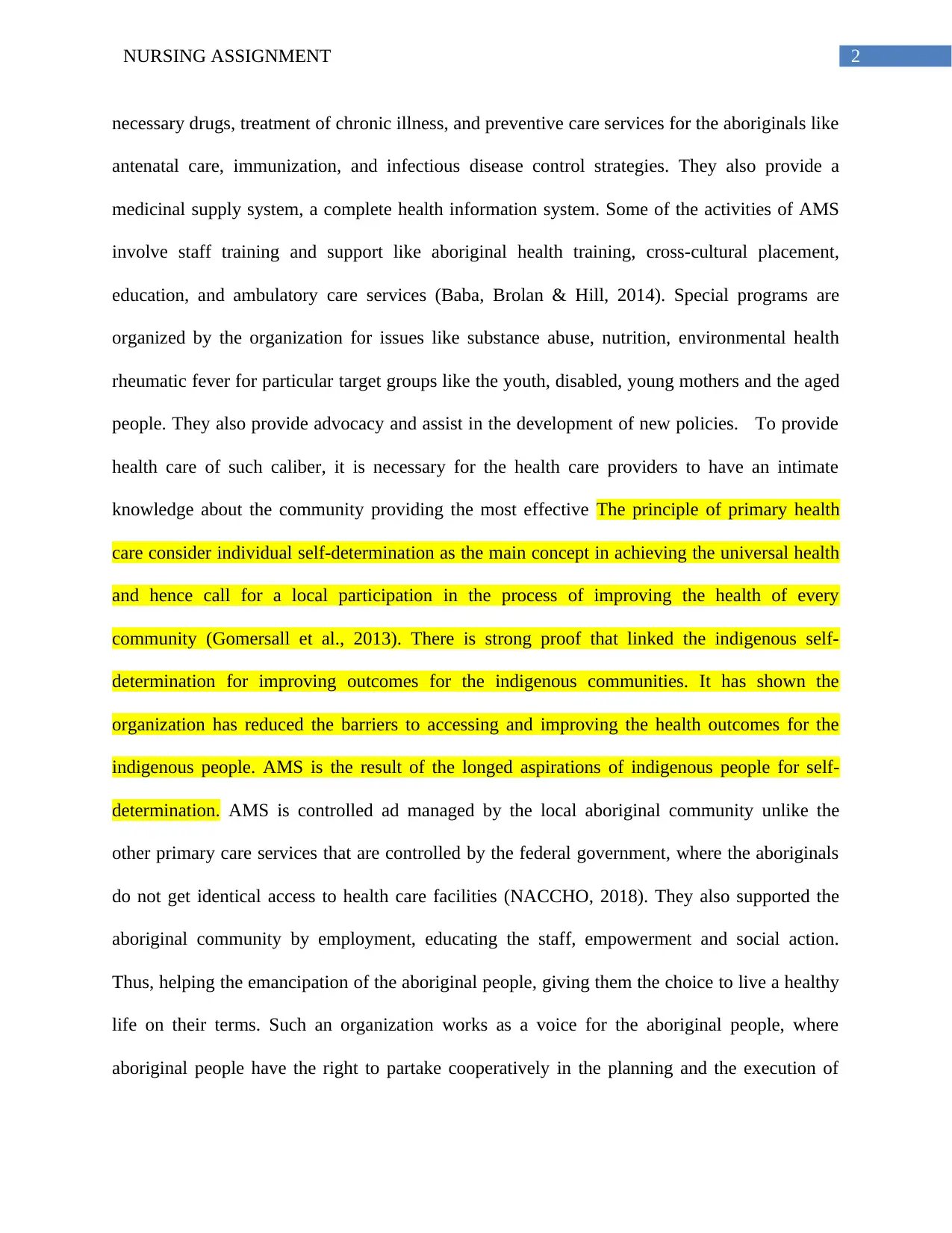
2NURSING ASSIGNMENT
necessary drugs, treatment of chronic illness, and preventive care services for the aboriginals like
antenatal care, immunization, and infectious disease control strategies. They also provide a
medicinal supply system, a complete health information system. Some of the activities of AMS
involve staff training and support like aboriginal health training, cross-cultural placement,
education, and ambulatory care services (Baba, Brolan & Hill, 2014). Special programs are
organized by the organization for issues like substance abuse, nutrition, environmental health
rheumatic fever for particular target groups like the youth, disabled, young mothers and the aged
people. They also provide advocacy and assist in the development of new policies. To provide
health care of such caliber, it is necessary for the health care providers to have an intimate
knowledge about the community providing the most effective The principle of primary health
care consider individual self-determination as the main concept in achieving the universal health
and hence call for a local participation in the process of improving the health of every
community (Gomersall et al., 2013). There is strong proof that linked the indigenous self-
determination for improving outcomes for the indigenous communities. It has shown the
organization has reduced the barriers to accessing and improving the health outcomes for the
indigenous people. AMS is the result of the longed aspirations of indigenous people for self-
determination. AMS is controlled ad managed by the local aboriginal community unlike the
other primary care services that are controlled by the federal government, where the aboriginals
do not get identical access to health care facilities (NACCHO, 2018). They also supported the
aboriginal community by employment, educating the staff, empowerment and social action.
Thus, helping the emancipation of the aboriginal people, giving them the choice to live a healthy
life on their terms. Such an organization works as a voice for the aboriginal people, where
aboriginal people have the right to partake cooperatively in the planning and the execution of
necessary drugs, treatment of chronic illness, and preventive care services for the aboriginals like
antenatal care, immunization, and infectious disease control strategies. They also provide a
medicinal supply system, a complete health information system. Some of the activities of AMS
involve staff training and support like aboriginal health training, cross-cultural placement,
education, and ambulatory care services (Baba, Brolan & Hill, 2014). Special programs are
organized by the organization for issues like substance abuse, nutrition, environmental health
rheumatic fever for particular target groups like the youth, disabled, young mothers and the aged
people. They also provide advocacy and assist in the development of new policies. To provide
health care of such caliber, it is necessary for the health care providers to have an intimate
knowledge about the community providing the most effective The principle of primary health
care consider individual self-determination as the main concept in achieving the universal health
and hence call for a local participation in the process of improving the health of every
community (Gomersall et al., 2013). There is strong proof that linked the indigenous self-
determination for improving outcomes for the indigenous communities. It has shown the
organization has reduced the barriers to accessing and improving the health outcomes for the
indigenous people. AMS is the result of the longed aspirations of indigenous people for self-
determination. AMS is controlled ad managed by the local aboriginal community unlike the
other primary care services that are controlled by the federal government, where the aboriginals
do not get identical access to health care facilities (NACCHO, 2018). They also supported the
aboriginal community by employment, educating the staff, empowerment and social action.
Thus, helping the emancipation of the aboriginal people, giving them the choice to live a healthy
life on their terms. Such an organization works as a voice for the aboriginal people, where
aboriginal people have the right to partake cooperatively in the planning and the execution of
⊘ This is a preview!⊘
Do you want full access?
Subscribe today to unlock all pages.

Trusted by 1+ million students worldwide
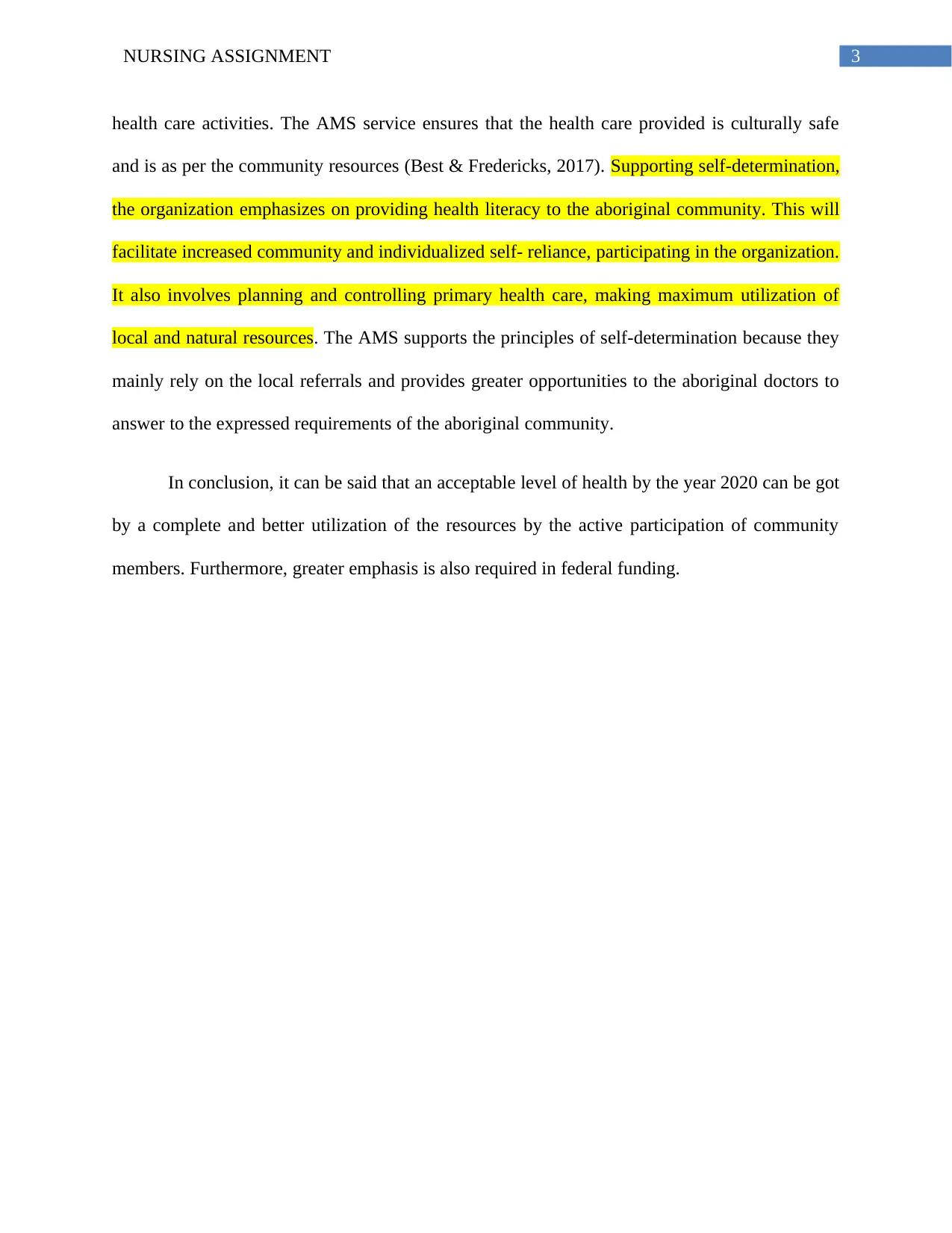
3NURSING ASSIGNMENT
health care activities. The AMS service ensures that the health care provided is culturally safe
and is as per the community resources (Best & Fredericks, 2017). Supporting self-determination,
the organization emphasizes on providing health literacy to the aboriginal community. This will
facilitate increased community and individualized self- reliance, participating in the organization.
It also involves planning and controlling primary health care, making maximum utilization of
local and natural resources. The AMS supports the principles of self-determination because they
mainly rely on the local referrals and provides greater opportunities to the aboriginal doctors to
answer to the expressed requirements of the aboriginal community.
In conclusion, it can be said that an acceptable level of health by the year 2020 can be got
by a complete and better utilization of the resources by the active participation of community
members. Furthermore, greater emphasis is also required in federal funding.
health care activities. The AMS service ensures that the health care provided is culturally safe
and is as per the community resources (Best & Fredericks, 2017). Supporting self-determination,
the organization emphasizes on providing health literacy to the aboriginal community. This will
facilitate increased community and individualized self- reliance, participating in the organization.
It also involves planning and controlling primary health care, making maximum utilization of
local and natural resources. The AMS supports the principles of self-determination because they
mainly rely on the local referrals and provides greater opportunities to the aboriginal doctors to
answer to the expressed requirements of the aboriginal community.
In conclusion, it can be said that an acceptable level of health by the year 2020 can be got
by a complete and better utilization of the resources by the active participation of community
members. Furthermore, greater emphasis is also required in federal funding.
Paraphrase This Document
Need a fresh take? Get an instant paraphrase of this document with our AI Paraphraser
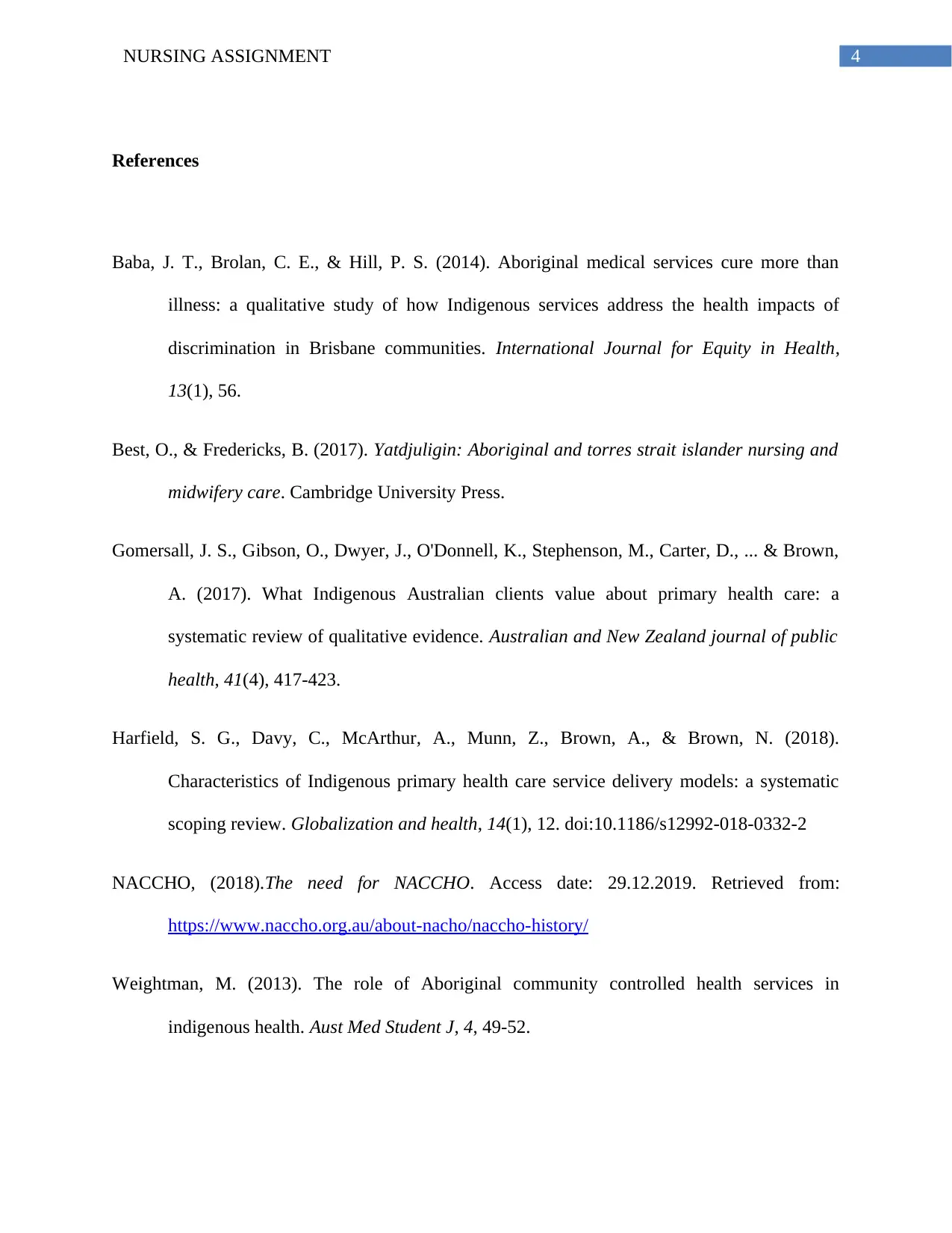
4NURSING ASSIGNMENT
References
Baba, J. T., Brolan, C. E., & Hill, P. S. (2014). Aboriginal medical services cure more than
illness: a qualitative study of how Indigenous services address the health impacts of
discrimination in Brisbane communities. International Journal for Equity in Health,
13(1), 56.
Best, O., & Fredericks, B. (2017). Yatdjuligin: Aboriginal and torres strait islander nursing and
midwifery care. Cambridge University Press.
Gomersall, J. S., Gibson, O., Dwyer, J., O'Donnell, K., Stephenson, M., Carter, D., ... & Brown,
A. (2017). What Indigenous Australian clients value about primary health care: a
systematic review of qualitative evidence. Australian and New Zealand journal of public
health, 41(4), 417-423.
Harfield, S. G., Davy, C., McArthur, A., Munn, Z., Brown, A., & Brown, N. (2018).
Characteristics of Indigenous primary health care service delivery models: a systematic
scoping review. Globalization and health, 14(1), 12. doi:10.1186/s12992-018-0332-2
NACCHO, (2018).The need for NACCHO. Access date: 29.12.2019. Retrieved from:
https://www.naccho.org.au/about-nacho/naccho-history/
Weightman, M. (2013). The role of Aboriginal community controlled health services in
indigenous health. Aust Med Student J, 4, 49-52.
References
Baba, J. T., Brolan, C. E., & Hill, P. S. (2014). Aboriginal medical services cure more than
illness: a qualitative study of how Indigenous services address the health impacts of
discrimination in Brisbane communities. International Journal for Equity in Health,
13(1), 56.
Best, O., & Fredericks, B. (2017). Yatdjuligin: Aboriginal and torres strait islander nursing and
midwifery care. Cambridge University Press.
Gomersall, J. S., Gibson, O., Dwyer, J., O'Donnell, K., Stephenson, M., Carter, D., ... & Brown,
A. (2017). What Indigenous Australian clients value about primary health care: a
systematic review of qualitative evidence. Australian and New Zealand journal of public
health, 41(4), 417-423.
Harfield, S. G., Davy, C., McArthur, A., Munn, Z., Brown, A., & Brown, N. (2018).
Characteristics of Indigenous primary health care service delivery models: a systematic
scoping review. Globalization and health, 14(1), 12. doi:10.1186/s12992-018-0332-2
NACCHO, (2018).The need for NACCHO. Access date: 29.12.2019. Retrieved from:
https://www.naccho.org.au/about-nacho/naccho-history/
Weightman, M. (2013). The role of Aboriginal community controlled health services in
indigenous health. Aust Med Student J, 4, 49-52.
1 out of 5
Related Documents
Your All-in-One AI-Powered Toolkit for Academic Success.
+13062052269
info@desklib.com
Available 24*7 on WhatsApp / Email
![[object Object]](/_next/static/media/star-bottom.7253800d.svg)
Unlock your academic potential
Copyright © 2020–2025 A2Z Services. All Rights Reserved. Developed and managed by ZUCOL.





